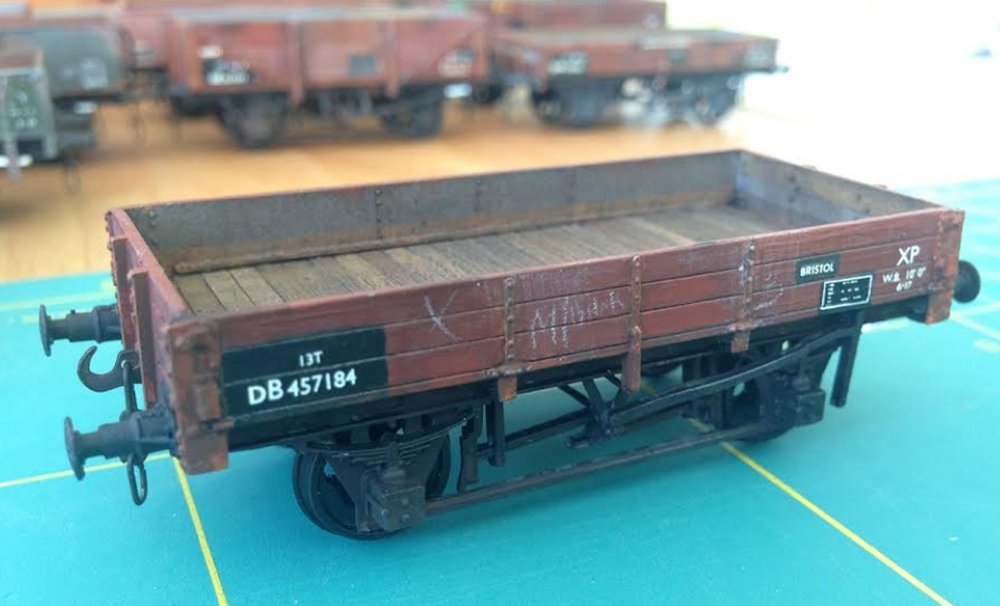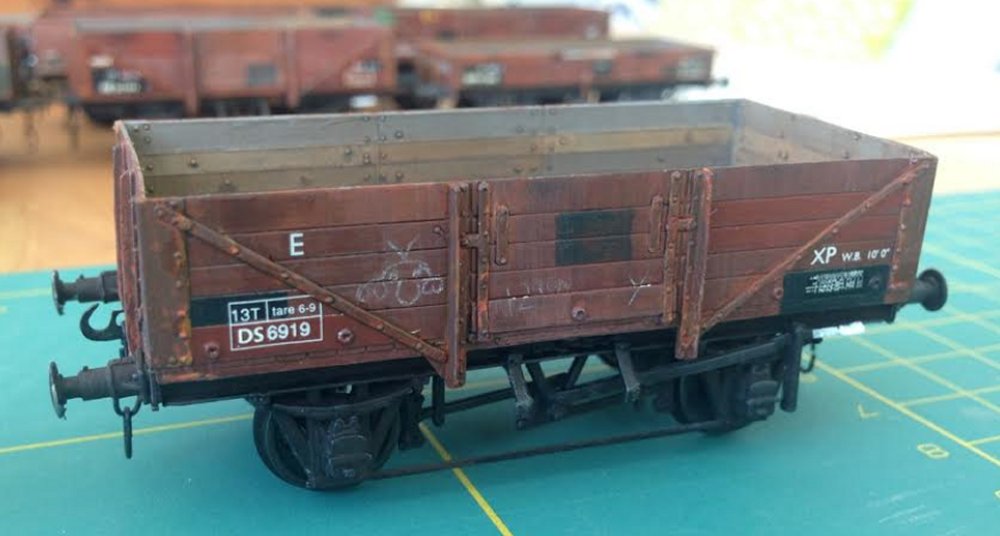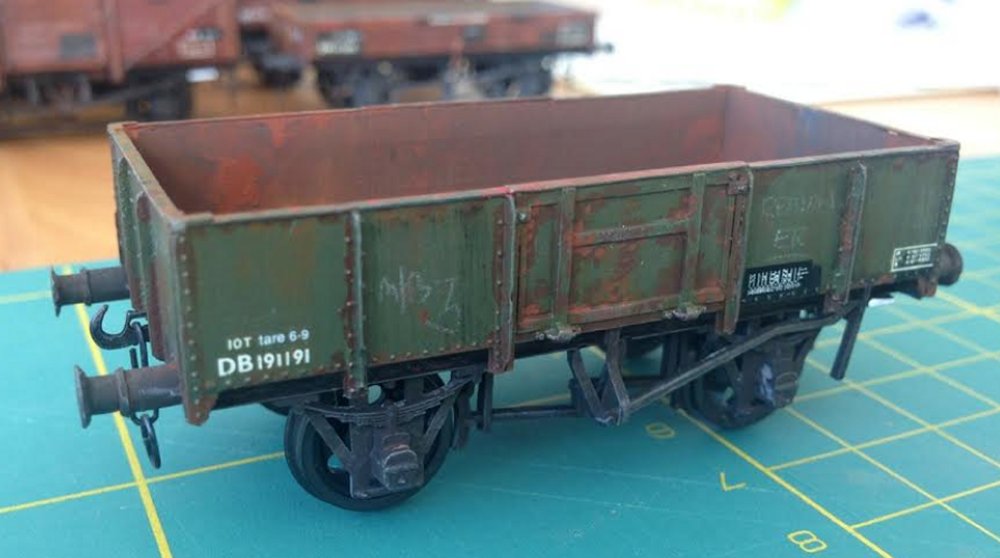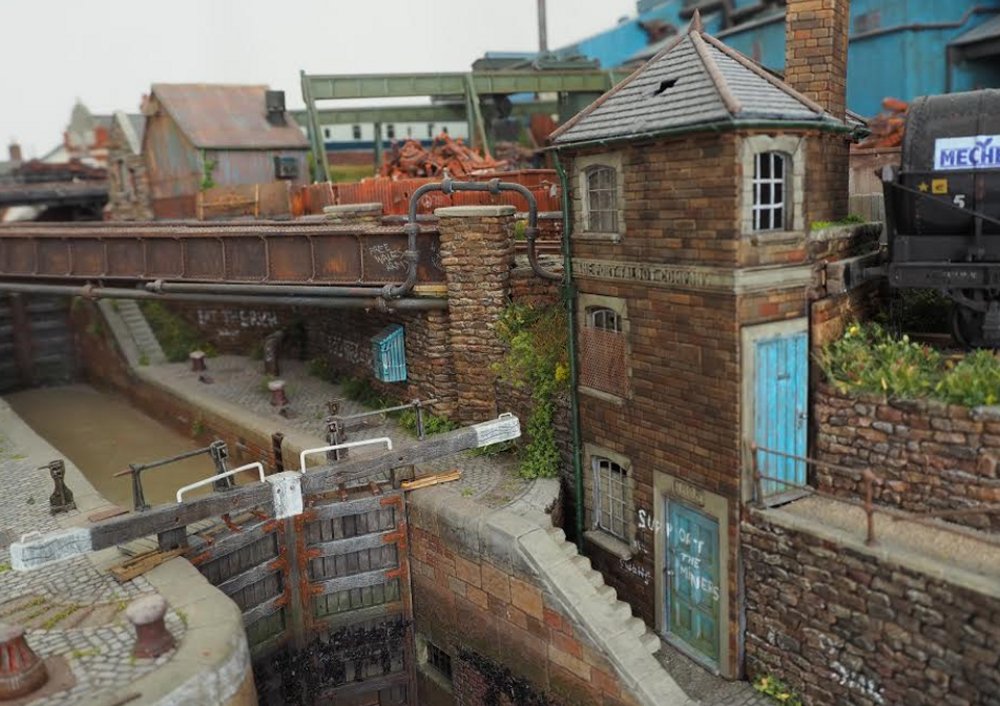*****************************************************************************************************************************************************************
AUGUST 2019 UPDATE
*****************************************************************************************************************************************************************
HYWEL THOMAS 

I had a rest from the layout during the hot weather so decided it would be good drying
temperatures for paint and transfers. Time to get those 22 additions to my (too large!)
spoil wagon fleet going. Here we see them after painting and lettering but before the
whiteness of the numbers had been toned down pre-matt varnishing. A mix of Ratio,
Cambrian, Parkside, Bachmann and Dapol.

A cruel close up of a Bachmann ex-LMS Medfit. Transfers on all these are a mix of Woodhead
(long gone but superb!), Modelmaster and HMRS.

Here we have a Ratio GW five-plank. By 1972 the old unfitted service stock was on its last
legs and being replaced by transferred fitted opens. This one is hanging in there and has
even gained a later style number box.

Another Bachmann wagon – an LNER steel Highfit but with wooden doors and vacuum braked by BR.
Again featuring the mixed era of lettering common at that time.

A Parkside Medfit but modified to represent one of the odd BR batch, most of which had five-plank
drop-sides. These were particularly unsuccessful and headed to the engineer fleet very early on
but the three-plank variety were very similar to the common LMS/BR design with a few subtle differences.

This one was from Cambrian and a very finely moulded kit. Some went to the SR and some to the
LNER (one of each is in the fleet).

Lastly an oddity found by Paul Bartlett on the ER. A former cupboard door mineral wagon built
for the SNCF and returned to BR in the 1950s. When and why this example was modified is unclear.
It was probably unique but there may have been more. As is clear a new drop door was fitted
and the body cut down. Here only because I had a made-up Parkside kit, which couldn’t be
justified in service during 1972, and so it’s briefly escaped from Hitchin and headed west!

And a final shot down on the AW&T trying out a new tripod and an app that operates the shutter
to avoid camera shake. The quayside behind the camera is next on the re-development list...
maybe this autumn?

*****************************************************************************************************************************************************************
KIER HARDY 

This 30 inch long off-scene baseboard carries 5 tracks (at the London end) to and from the
storage sidings via the 180 degree end curves. With no room to accomodate it at home until
now, they have only ever been used at exhibitions. The purpose of the baseboard is to allow
movements between the Up Slow (where the Class 501 unit is seen), back across onto the
the Down Fast, for the shuttling of local suburban services and light engine moves. The coke
train is on the Up East London route.

On the other side of the room at the other end of the curve is another near matching baseboard
which allows the Up Slow to access both Up and Down sidings in the storage yard via the single
slip. As this crossing is for occasional use, all the point and electrical switching is carried
out locally on the board. The stepped shelving behind and in front of the tracks is an ideal
location for storing locomotives to be used on formations in the yard, or working light to the
depot and back. A small maintenance area has been made at the front, primarily for cleaning wheels,
lubrication and adjustments. The simple but effective loco cradle was made for me by Greg, out of
bits of wood, cork sheet and some foam rubber packaging, and has proved invaluable for keeping
the rolling stock protected whilst undergoing routine servicing.

At the station end of the scenic section, new end curves have been constructed to replace the
old make-shift arrangement. Due to the narrow width of the building, it's not possible to use
the exhibition end curve boards, resulting in a heavy and bespoke piece of hardware that only
needs to be slid aside a few inches to enable release of the scenic baseboards when required.
The nearest track is the branch which comes from the depot, the two lugs previously being used as
guides and electrical connections to a set of short cassettes. The branch line can now be used to
its full potential with a connection to both the Up and Down sidings in the yard.

Paul is seen laying some of the new curved track, a mixture of both SMP and C&L with all
the inside of the curve sleeper webbing cut away to aid smooth transitions... the inner track
is set to a 34 inch radius which everything seems happy to negotiate smoothly. Many problems have
been encountered over the years at this end of the layout when it's at home, as the return curves
were poorly constructed in the first place. One good thing to come out of the previous dodgy rail
joints and bumpy curves, is the increased reliability of the rolling stock which have been fettled
for a degree of articulation to ride rough track. Now when Paul's loco falls off, at least he won't
be able to blame the trackwork!

The internal partition walls of the building have been reconfigured to allow enough space for the
new end curves, with some space set aside for access. The adjacent room hosts the curved boards,
this one being semi-permanent and built from large section stud wall timber with 9mm plywood tops.

Looking back through to the railway room with the new end curves finished, retaining walls cut
from hardboard sheet and spray painted.

The removable lighter weight baseboards work in progress, with the one to the right being
the bridge section.

To finish off at Hornsey this month, here's Greg's D601 having taken part with the testing
of the layout.

And a refreshed Hymek D7036 with etched nickel silver cabside numbers.
*****************************************************************************************************************************************************************
PETE JOHNSON 

A couple of existing models have been the subject of re-works recently - The first is
Heljan Class 27 ‘D5410’, this example was one of the Midland Region allocated locos when new,
and only moved north to Scotland during 1969. This made it unsuitable to work with the small
North British 0-4-0 shunters, which were all withdrawn by early 1968. To give better
historical accuracy on the layout, the model has been re-worked as an earlier example,
‘D5355’, which was delivered new to Glasgow Eastfield in 1961, and never re-allocated.

























